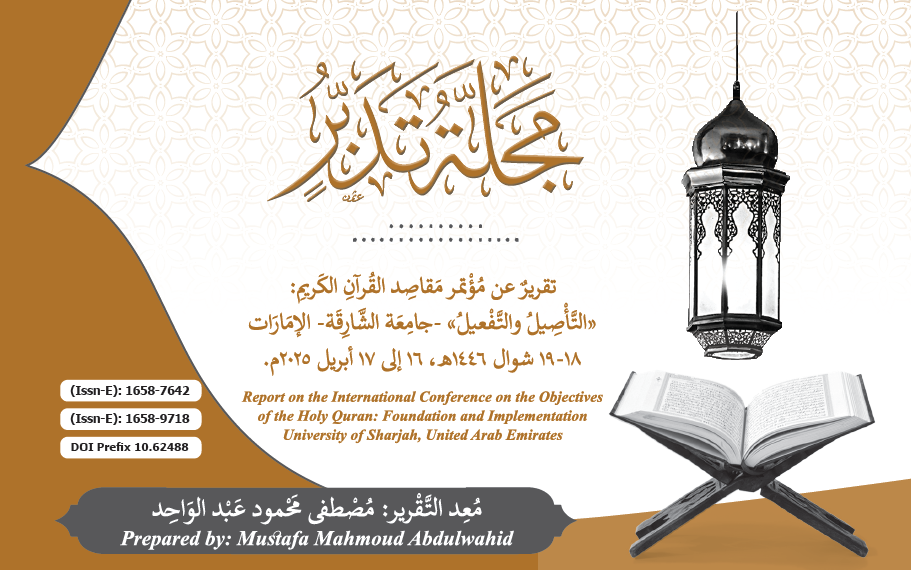Report on the International Conference on the Objectives of the Holy Quran: Foundation and Implementation -University of Sharjah, United Arab Emirates-
Main Article Content
Abstract
The report covered the proceedings of an international scientific conference titled: "The Objectives of the Holy Qur’an: Establishment and Application," organized by the College of Sharia and Islamic Studies in collaboration between the Departments of Theology and Jurisprudence and Its Principles at the University of Sharjah in the United Arab Emirates.
The conference was held from 18–19 Shawwal 1446 AH, corresponding to 16–17 April 2025 CE.
The conference addressed a significant topic concerning the objectives of the Qur’an, both in terms of their theoretical establishment and practical application, aiming to serve the Book of Allah, the Exalted, through understanding, contemplation, and implementation. The researcher chose to present the conference in Tadabbur journal due to its alignment with the magazine’s publication scope, objectives, vision, and mission.
The report highlighted several aspects, including the conference’s importance and its objectives, which can be summarized as follows:
- Establishing a clear concept of Qur’anic objectives, identifying their levels and types.
- Exploring the efforts of Muslim scholars in addressing Qur’anic objectives theoretically and practically.
- Formulating a theoretical framework for the methods of uncovering Qur’anic objectives and defining their guidelines.
- Highlighting the scholarly and interpretative impact of activating Qur’anic objectives.
- Examining the role of Qur’anic objectives in shaping the human being as a vicegerent (khalifa), guiding civilization, and fostering development.
These objectives reflect a deep commitment to advancing Qur’anic and objective-based research while connecting it to contemporary issues facing the Muslim community.
The report then outlined the conference’s themes, followed by a review of its sessions and the research papers presented.
The conference recommendations were presented, with the most prominent being:
- The necessity of prioritizing and celebrating the objectives of the Holy Qur’an.
- Emphasizing the need to deepen awareness of the Qur’an’s objective-based role.
- Encouraging universities, colleges, and research centers to enhance collaborative scientific efforts.
- Urging postgraduate researchers to focus on writing theses and dissertations in the field of Qur’anic objectives.
- Calling for the support of research in the field of Qur’anic objectives through specialized research centers.
- Proposing the creation of an encyclopedia titled: "Encyclopedia of the Objectives of the Holy Qur’an."
- Highlighting the importance of leveraging artificial intelligence, virtual reality, and augmented reality technologies in serving the objectives of the Qur’an.
- Advocating for the organization of conferences and seminars focused on the objectives of Islamic law in general, and those of the Qur’an and Sunnah in particular.
The report also reviewed statistics and data related to various aspects, including: the total scientific output of the conference papers based on its themes, the countries of participating researchers, their academic ranks and affiliations, the types of participation (individual or collaborative), and the gender distribution (male, female, and mixed participation). These metrics, known as bibliometric analysis, were presented in a concise and simplified manner suitable for scientific reports, avoiding excessive elaboration.
Keywords:
Qur’anic Objectives, Objective-Based Establishment, Qur’anic Contemplation, Bibliometric Study, Tadabbur journal, Holy Qur’an, Qur’anic Studies, Qur’anic Exegesis and Sciences, Objectives of Islamic Law, Principles of Jurisprudence.
Downloads
Article Details
Conference Proceedings Volume
Section

This work is licensed under a Creative Commons Attribution-NonCommercial-ShareAlike 4.0 International License.
Indicating to the intellectual property, copyrights, and open access right:
According to the Budapest Initiative 2002; tadabbur Journal, which is issued by Khibrat Taibah For Research and Studies in Medina, provides free open access to its publications, and applies the Creative Commons license:
Attribution- Non-Commercial 4.0 International (CC BY-NC 4.0) for the works it publishes from peer-reviewed scientific research and reports, which are freely available on the Internet, and which allows any user to read, download, copy, and distribute (Convert), print, search, or create links to the full texts of the journal’s research and publications, and analyze them in an automatic manner for discovering them, sending them as software data, or using them for any other legal purpose, without financial, legal, or other technical barriers beyond those related to Internet access.
It also highlight that the only barrier to reproduction and distribution, and the only role of copyright in this field, is the necessity of granting the authors of the journal’s research and reports and the publisher the journal; Control over their works, and the right to official recognition and reference citations.
How to Cite
References
- انظر: خبر صحفي: https://www.sharjah.ac.ae/ar/Academics/Sh/Conferences/Conference-the-Objectives-of-the-Gracious-Quran
- انظر: خبر صحفي على موقع: https://sharjah24.ae/ar/Articles/2025/04/16/a15
-انظر: مقالة موقع مركز تفسير تقرير عن المؤتمر https://tafsiroqs.com/article?article_id=4467
تقرير عن المؤتمر مسترجع بتاريخ: 20-12-1446هـ، نشر بتاريخ: 7 ذو القعدة 1446هـ، 5 مايو 2025م، كما حصل معد التقرير على نسخة من أوراق وتوصيات المؤتمر من إدارة المؤتمر بالإمارات.
Akhbār ṣaḥafī: Muʼtamar maqāṣid al-Qurʼān al-Karīm. Retrieved from: https://www.sharjah.ac.ae/ar/Academics/Sh/Conferences/Conference-the-Objectives-of-the-Gracious-Quran
Akhbār ṣaḥafī. Retrieved from: https://sharjah24.ae/ar/Articles/2025/04/16/a15
Maqālah min mawqiʻ markaz tafsīr: taqrīr ʻan al-muʼtamar (Maqāṣid al-Qurʼān al-Karīm: al-taʼṣīl wa-al-tafʻīl). Nashara bi-tārīkh 7 Dhū al-Qaʻdah 1446 AH, 5 Mayū 2025 M. Isturjiʻa bi-tārīkh 20-12-1446 AH. Retrieved from: https://tafsiroqs.com/article?article_id=4467





